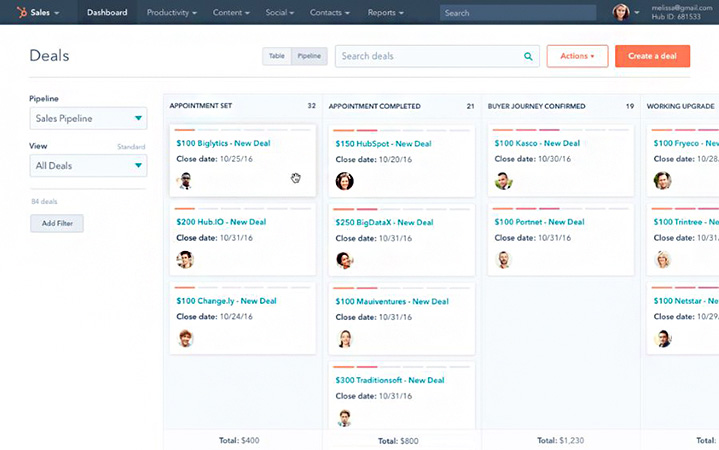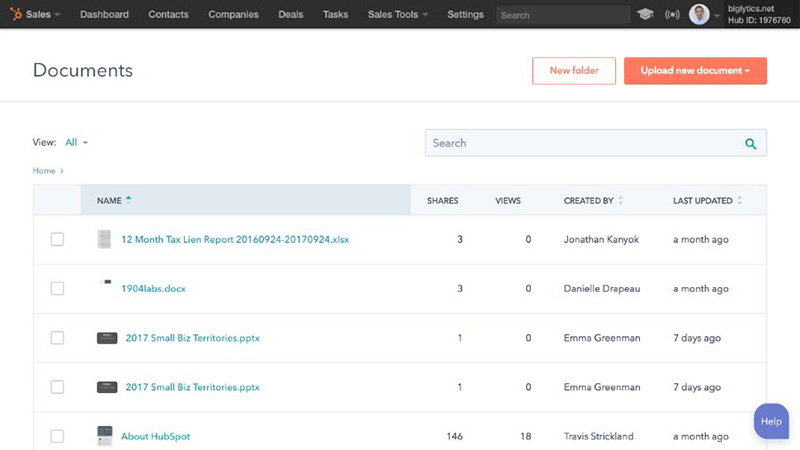A business proposal is a document sent to a prospective client that outlines a firm’s product or service offerings. It also explains how you will provide a solution, the cost, timeline, and qualifying information, such as your background and prior work experience. In this article, we outline eight steps for how to create a business proposal, offer a free proposal template, and provide best practices for writing proposals.
Free Business Proposal Template
Creating a sales proposal can feel tedious, especially if you’re drafting it from scratch each time. We’ve created a free template that you can use as a resource for your sales proposal.
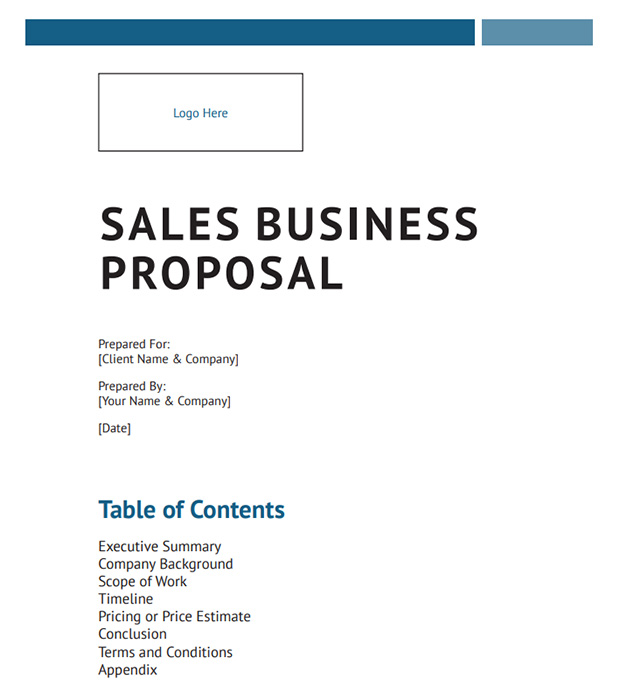
Thank you for downloading!
💡 Quick Tip:
Use ClickUp for free to see your entire sales funnel in one place.
- ✓ Free forever, unlimited users
- ✓ Manage all leads, emails and tasks
- ✓ Create presentations, lead forms, and contracts
- ✓ Professional workspace templates
After you’ve downloaded our free template above, you can now customize it according to your business needs as you follow the steps to writing a proposal below:
The first step in learning how to write a business proposal is knowing what needs to be included. Government agencies, public universities, and large corporations typically use requests for proposals (RFPs). These are formal solicitation requests for products or services in which the requirements are normally laid out line by line and must be followed precisely.
If you are writing a proposal for a potential customer undergoing your unique sales process, include things a decision-maker would like to see. For instance, pricing, timelines, and the proposed solution regarding quantities and the mode of product or service delivery are critical purchasing factors enclosed in the document.
Pro tip: ClickUp is a free-forever project management tool that helps teams:
- Create professional proposals
- Collaborate with shared tasks and team chat
- Assign tasks to teammates
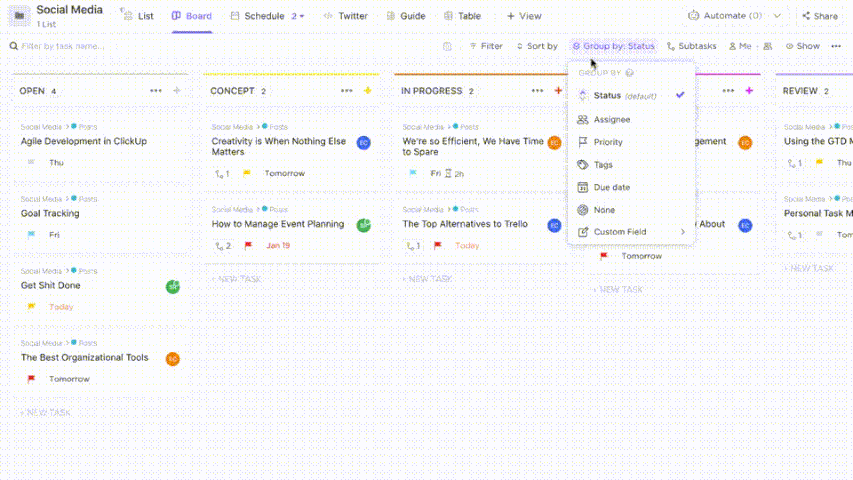
ClickUp project management board (Source: ClickUp)
Gathering essential information and materials for your proposal can be complex because each potential client may want different details. This could demand other personnel to get involved in pulling the documents and information needed. For instance, some may only request the price and proposed solution, while others will ask for your background story, client reference lists, and work samples to show you’re qualified.
While learning how to write a proposal for business purposes, you may have to dig around your file database for company information, employee biographies, marketing materials, and pricing sheets. Keeping all resources needed for a proposal in one place makes this process easier. Use customer relationship management (CRM) systems to track your proposal progress and acquire what’s needed to draft it in one place.
Pro tip: HubSpot is a popular CRM platform that lets you monitor opportunities using sales pipelines and store documents—all in one system. You can utilize the Sales Documents feature to store, share, and customize templates and materials you’ll need for your proposals.
Your proposed solution involves the processes, materials, product quantities, and personnel required to fulfill the offerings or address your customer’s problem statement. Additionally, it should be included in the scope of work section in the proposal. For businesses that only provide a product, such as equipment for a manufacturing plant, this step could be as easy as knowing the quantity and having a logistics plan for delivery and installment.
For more service-based businesses, such as business consultants or content development services, there will likely be more steps and deliverables to complete the work. Regardless of your business, you can use the five W’s and an H methodology to construct a proposed solution that addresses your prospect’s primary pain points:
- Who: Who will be involved, do the work, manage, and be a point of contact for the prospect?
- What: What solutions or products will be delivered, and what resources, processes, or technology will be used?
- Where: Where will work be done or delivered to?
- When: When will the work start and be completed, what are the key milestones throughout the project, and when is each deliverable expected to occur?
- Why: Why did you choose this particular solution for this customer’s needs?
- How: How will work be done, managed, and checked for high quality and customer satisfaction?
For example, a business-to-business (B2B) content writing business might be trying to address a statement of needs issued by a client: “We would like to express thought leadership on the topic of the Zero Trust Cybersecurity Framework.” In this case, the business could use the solution in this business proposal example:
The objective of this business proposal is to demonstrate how ABC Writing Agency can promote the thought leadership of Cybersecurity Corp. for the Zero Trust Security Model. We believe the best course of action is to research and copyright a branded e-book (roughly 4,000 words) regarding Zero Trust Security, the details of the solution, its benefits, and the modern-day security challenges it solves (what) with the final product completed in August 2022. (when) The e-book will use your logo and branding scheme to convey your personal grasp on the subject and thought leadership using a series of direct quotes and statistical callouts. (why)
To ensure high-quality work and client satisfaction, we will begin with an initial call to construct a detailed outline discussing the sections, style guides, tone, and to retrieve direct quotes. Following an initial draft, multiple rounds of edits will take place between Cybersecurity Corp. and ABC Writing Agency to develop a final draft. (how)
The project will be led by our senior editor, Collin Buchanan, and content manager, Jake Cunningham, who comes from the world of cybersecurity. Our team will utilize and manage freelancers experienced in writing e-books on technical topics to research and copyright the asset. (who) All work will be completed by us virtually and delivered via Google Docs. (where)
Once you know how you’ll provide your product or service, the next step in writing a proposal is formulating the costs to specify in the document’s pricing section. This is one of the toughest steps because of all the factors that need to be considered, such as product cost and other expenses. That’s why it is critical to accurately communicate your costs to avoid losing a deal for overcharging—or worse—winning a deal with significantly underestimated costs.
As you price everything, you can either do a flat fee, hourly rate, per-unit charge, or some combination of the three. Sometimes, it’s best to work backward by establishing your desired probability first in the form of a percent like 20% profit or a flat dollar amount such as $10,000 above the work cost.
For example, you want to make a 20% profit on the work for an equipment installation job for a manufacturing business, and you’re pricing using a flat fee. You’ve itemized the costs as the following:
- 1 x $80,000 manufacturing equipment = $80,000
- 3 installation/delivery employees x 5 hours x $32 per hour = $480 wages
- $480 employee wages x 7% employer payroll tax = $33.6 payroll tax
- $480 employee wages x 20% benefits and workers’ compensation = $96 benefits and compensation
- $200 for the delivery truck and gas = $200 for delivery costs
When you add all the itemized expenses, the total cost for this installation job will be around $80,809. To get the total, you need to charge this customer to meet your desired profitability, and multiply it by 20% to get $16,162. Add that to your total cost ($80,809 + $16,162), and $96,971 is the flat fee you will charge for the installation job.
Pro tip: Struggling to visualize your pricing process? Try using these seven free estimate templates. Designed for various business types, these templates allow you to outline and itemize the costs of providing work to share with your customers to help win more deals easily.
Now that you know your proposal requirements, have gathered the necessary information, determined the proposed solution, and calculated pricing, you are ready to draft the document. Following along with our free template, your draft will consist of the following elements:
The title page leans more toward showing the professionalism of your business than providing information. There should be a specific title establishing the purpose, such as “ABC Writing Agency Proposal for Cybersecurity Corp. to Promote Thought Leadership on Zero Trust Security.”
Also, be sure to indicate who the proposal was prepared for in terms of the decision-making person and their company name. Add your logo to the front and the contact information for the primary point of contact for your business so they can contact you with further questions.
Use a table of contents to break down each part of the proposal for business so they can easily navigate through it. Because of the digital age we live in, we recommend linking your table of contents electronically to each associated section. That way, those reading your proposal can go to any part of the document by clicking on the table of contents.
The executive summary takes everything in your proposal and compresses it into one paragraph. Essentially, if a reader reads this section, they should be able to grasp the general idea of your solution. Here’s a business proposal example using the content writing example above:
With over 10 years of experience in writing high-quality marketing assets, we are eager to assist Cybersecurity Corp in its endeavor to promote thought leadership on Zero Trust Security. We plan to achieve this by writing a comprehensive e-book using engaging copy, stat callouts, and direct quotes from your leaders to help associate the security framework with your brand.
Here’s your time to talk about your inception story, mission statement, founding purpose, and company history. You can also provide biographies and professional pictures of your company founders, leaders, and key personnel that might be involved in the work you provide.
This is also the time to express your unique selling proposition. In other words, addressing the question “why choose us” over competitors. Lastly, if you’ve had any recognition or won any company awards, this is the section to highlight those successes.
This section correlates with creating your proposed solution in step three as you present it in an actionable business plan. Describe the work that will be completed and the tangible deliverables associated with it.
In this small business proposal example, we see how a content writing business might construct a scope of work:
We will provide content writing services to create predetermined marketing assets for Cybersecurity Corp. This includes researching online data for usable information, interviewing subject matter experts (SMEs) for additional insights and quotes, copywriting drafts, inserting callouts, and making edits per revision requests made by Cybersecurity Corp. Deliverables for the scope of work above include:
- 1 x outline developed by ABC Writing Agency and approved by Cybersecurity Corp.
- 1 x drafted e-book (max. 4,000 words) delivered by Google Doc
No matter how long your scope of work is, it’s crucial to avoid industry or technical jargon that the general audience may not understand. Take the time to review the scope of work and translate any statements that may be misunderstood or confusing.
Be sure to indicate how long you expect it to take to complete the entire scope of work. It’s also a good idea to provide estimates for each milestone or individual deliverable you set. Whenever possible, present the information visually to help your reader absorb it better. Below is a sales proposal timeline example for a sales consulting business and its milestones.
For this section, take the price calculation you did in step four and present it to the potential customer. While you should itemize it to show where the price comes from, avoid adding your desired profitability, as that should be private to your business. Make sure it’s clear as to how each item is priced, whether that be hourly, per unit, or a flat fee.
This section should also be used to explain payment expectations, e.g., when invoices must be paid by, how much money is required upfront vs after work is completed, refund policy, and if other billable expenses can be included automatically or require client approval.
Be upfront with your estimate if you don’t know how many units you’ll need or how many hours it will take to accomplish your business offering. Provide an explanation and an estimated range.
The final sections should include additional information that could be useful to your prospective client. A conclusion should express your gratitude for the opportunity and explain the next steps to move forward. Terms (or terms and conditions) can be added in a proposal or in the service agreement to cover legal aspects of a working contract, like contract dispute policies, confidentiality, rules on subcontracting, etc.
The appendix is optional but would utilize visuals or supplemental documents to enrich your proposal. For instance, you might include links to sample work, a client reference list, or a catalog of options for materials or software vendors from which the client can choose.
Once you have completed the first draft of your proposal, run it by multiple departments to ensure it is comprehensive and accurate. Some things to consider as you review it for potential revisions:
- Has strong readability: The proposal uses appropriate style, tone, and structured sentences to create a clean flow of information understood by the specific reader.
- Avoids grammar and technical errors: The proposal avoids punctuation, spelling, or other errors related to proper writing mechanics.
- Addresses requirements: The proposal contains all the information and sections required to meet the reader’s or customer’s needs and objectives.
Use editing tools such as Grammarly to evaluate your business proposal writing for enhanced quality. Grammarly lets users upload text into a system to check for grammar and spelling mistakes as well as for engagement and readability of content. There’s also a plagiarism check feature to evaluate the text to billions of pages online. You can even adjust style preferences when subscribing to Grammarly Business to ensure it meets all your goals.
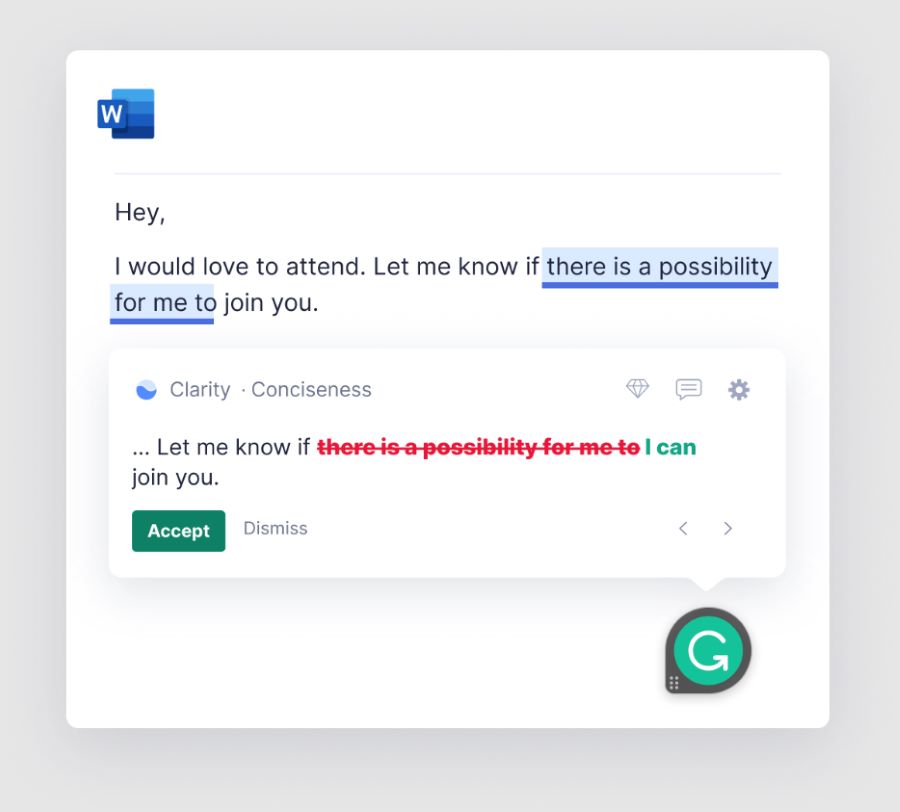
Grammarly Business’ in-line writing suggestion (Source: Grammarly Business)
Pro tip: Use graphic design tools like Canva to give your sales proposal the professional touch it needs. Canva is a user-friendly platform with thousands of free templates for presentations, marketing materials, social media posts, and proposals for business. Users of all design skill levels can easily turn regular copies into visual masterpieces.
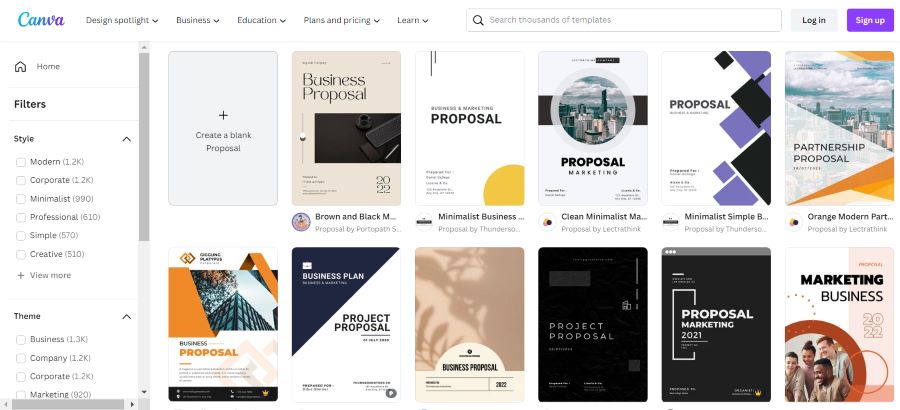
Canva’s sales proposal templates (Source: Canva)
Now that your proposal is drafted, edited, and has the aesthetics it needs, it’s time to send the document for review. More formal submissions for RFPs may require that you submit them in person, electronically, or both, so review those provisions carefully before sending them in.
Some sales plans incorporate unsolicited proposals to new leads to present problems they didn’t know existed with viable solutions they could offer. In these cases, they use the proposal to get their foot in the door and create sales opportunities.
When taking this course of action, it’s important to add context to the unsolicited proposal. For instance, in a sales email, briefly introduce yourself, your business, and what services you provide. Furthermore, indicate why you wanted to send a proposal to them specifically and let them know they can reach out if they wish to discuss it further.
Even after you send a proposal, the process is not over. Make time to follow up to confirm the contact received the proposal and see if they have any questions. Because of the proposals’ details, there are usually other clarification steps in the procurement process, such as interviews, client meetings, or sales presentations before work begins.
We recommend using a customer relationship management (CRM) system with task management capabilities to ensure sales reps don’t forget to reach out to a prospect after a proposal is initially sent. A CRM like Pipedrive lets you design and assign tasks to team members from within a project. You can also create projects that are linked to open or won deals.
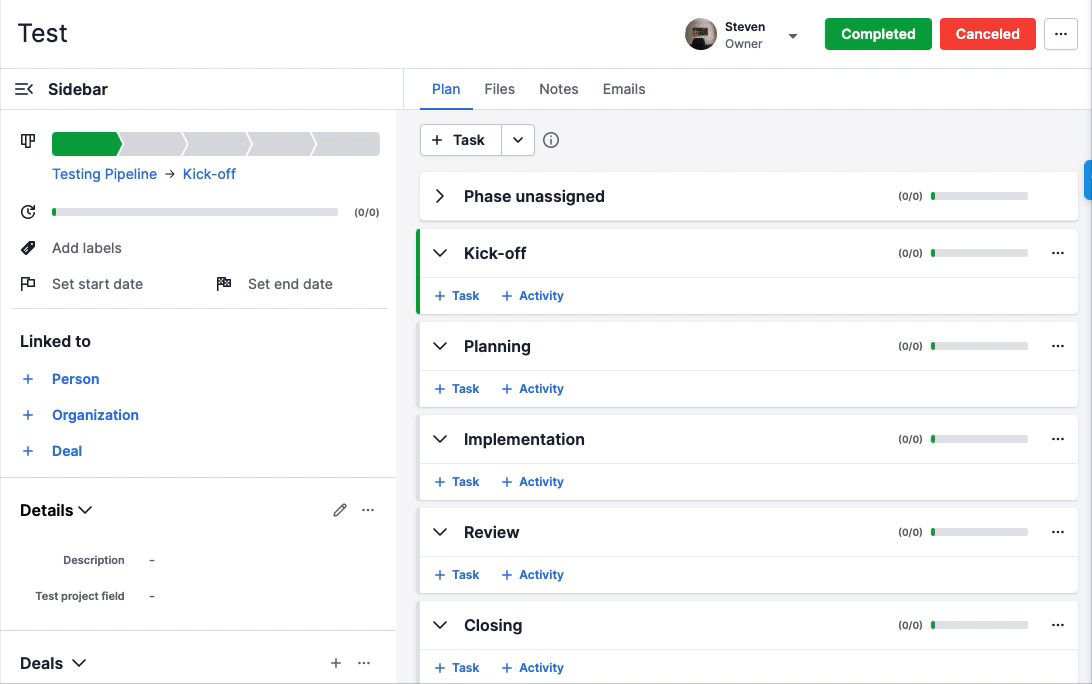
Pipedrive’s project and task management feature (Source: Pipedrive)
Best Practices in Writing Sales Proposals
Now that you know the steps in how to write a business proposal, there are a few tips you can practice and maintain to produce thoughtful and effective proposals.
When learning how to make a business proposal, remember to write short, simple sentences. While there is no strict rule on the business proposal format or length, make sure it is straightforward and easy to understand. Avoid loading it with too much business jargon and fancy words. Instead, strike the sweet spot between conveying essential information and ensuring anyone who reads it can understand it.
The first thing to do when learning how to do a business proposal is to outline all the major sections of your document. This should also include all the pertinent information that you want to get across. The business proposal outline will help you stay focused on the main points of the document and keep your ideas from drifting away.
Capture your prospect’s attention by including quantitative data and figures highlighting your offerings and the value of your company. For example, you can show your month-on-month sales trends as proof of your stellar performance. Adding visual elements like charts and graphs can also help make your proposal more engaging.
After the prospect reads your proposal, direct them to the next step. Use a call to action with a verb that defines what they should do to act on their interest in your proposal. Examples of CTAs are “Subscribe today” or “Download this guide now.” You can also use a CTA with a no-obligation statement like “Sign up, it’s free” for prospects who perceive risks in taking action.
Another excellent idea when adding CTAs is to create a sense of urgency to make your prospect feel that now is the best time to subscribe to your service. Some people are motivated to do something right away for fear of missing out (FOMO). That said, phrases like “Limited-time offer” and “On sale now for 20% off” can trigger action from prospects.
Each company has a different brand voice and personality. Staying true to your business brand is a great way to stand out among your competitors. For instance, if your company sells baby clothes, it is best to use language that parents with babies can relate to, like “cute and cuddly” or “snug and comfy.” Use a more formal tone of voice in your proposal if you are selling office wear.
Bottom Line
Many business owners and sales managers would like to standardize their proposal-writing system. However, it can be tricky to address the unique needs of every solicited and unsolicited opportunity to get the correct information in order and present their proposed solutions. Our how-to sales proposal examples and free template will help you streamline your bidding process to win more deals.
